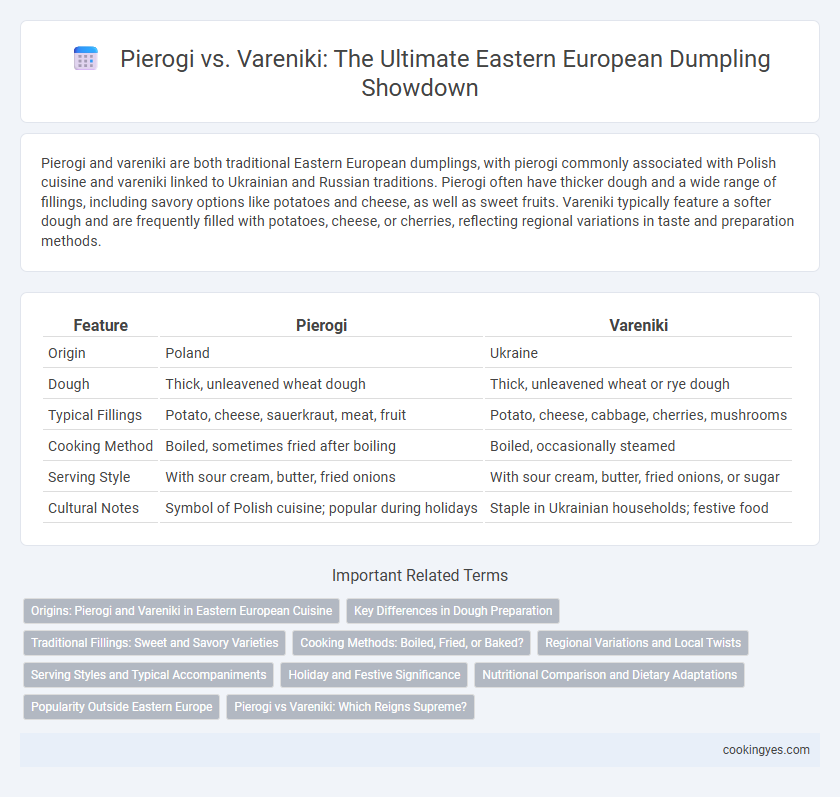Pierogi and vareniki are both traditional Eastern European dumplings, with pierogi commonly associated with Polish cuisine and vareniki linked to Ukrainian and Russian traditions. Pierogi often have thicker dough and a wide range of fillings, including savory options like potatoes and cheese, as well as sweet fruits. Vareniki typically feature a softer dough and are frequently filled with potatoes, cheese, or cherries, reflecting regional variations in taste and preparation methods.
Table of Comparison
| Feature | Pierogi | Vareniki |
|---|---|---|
| Origin | Poland | Ukraine |
| Dough | Thick, unleavened wheat dough | Thick, unleavened wheat or rye dough |
| Typical Fillings | Potato, cheese, sauerkraut, meat, fruit | Potato, cheese, cabbage, cherries, mushrooms |
| Cooking Method | Boiled, sometimes fried after boiling | Boiled, occasionally steamed |
| Serving Style | With sour cream, butter, fried onions | With sour cream, butter, fried onions, or sugar |
| Cultural Notes | Symbol of Polish cuisine; popular during holidays | Staple in Ukrainian households; festive food |
Origins: Pierogi and Vareniki in Eastern European Cuisine
Pierogi and vareniki both originate from Eastern European cuisine, with pierogi traditionally linked to Polish culinary heritage and vareniki associated with Ukrainian and Russian regions. These dumplings share similar dough and fillings but reflect distinct regional flavor preferences and preparation methods shaped by local history. Their origins highlight the cultural diversity and deep-rooted culinary traditions across Eastern Europe.
Key Differences in Dough Preparation
Pierogi dough typically incorporates a combination of flour, water, eggs, and salt, resulting in a slightly denser and firmer texture ideal for holding varied fillings during boiling or frying. Vareniki dough, however, often omits eggs and uses just flour, water, and sometimes sour cream, producing a softer, more delicate consistency that cooks quickly. This fundamental difference in dough ingredients significantly affects the dumplings' texture and flexibility throughout traditional Eastern European cooking methods.
Traditional Fillings: Sweet and Savory Varieties
Pierogi and vareniki, staple Eastern European dumplings, offer a range of traditional fillings with both sweet and savory varieties. Pierogi fillings typically include potatoes, cheese, sauerkraut, and mushrooms, while sweet versions feature berries, cherries, or sweetened cheese. Vareniki often showcase similar savory options like potatoes and cabbage, with sweet fillings such as cherries, blueberries, and cottage cheese, reflecting regional culinary preferences.
Cooking Methods: Boiled, Fried, or Baked?
Pierogi and vareniki, traditional Eastern European dumplings, share similar cooking methods such as boiling, frying, and baking, each imparting distinct textures and flavors. Boiling is the most common technique, resulting in soft, tender dumplings with a subtle chew, while frying after boiling adds a crispy, golden exterior that enhances richness. Baking offers a less traditional but delicious alternative, producing a firmer, slightly browned crust that complements hearty fillings like potato, cheese, or sauerkraut.
Regional Variations and Local Twists
Pierogi and vareniki share a common Eastern European heritage but differ in regional variations and local twists, with pierogi originating mainly in Poland and featuring thicker dough and a variety of fillings like potato, cheese, and sauerkraut. Vareniki, popular in Ukraine and Russia, often use a softer dough and emphasize sweet or savory fillings such as cherries, potatoes, and farmer's cheese. These subtle differences reflect the diverse culinary traditions and localized ingredients found across Eastern European regions.
Serving Styles and Typical Accompaniments
Pierogi are often served boiled or fried, accompanied by sour cream, caramelized onions, or crispy bacon bits, reflecting Polish culinary traditions. Vareniki, common in Ukrainian cuisine, are typically boiled and served with butter, sour cream, or sometimes sweet fillings topped with fresh fruits or sugar. Both dumplings feature versatile fillings but differ in serving styles, with pierogi frequently enjoyed as savory hearty meals and vareniki embraced in both savory and sweet applications.
Holiday and Festive Significance
Pierogi and vareniki hold deep cultural and festive importance in Eastern European holiday traditions, often symbolizing prosperity and family unity. Pierogi, predominantly associated with Polish celebrations such as Christmas Eve (Wigilia), are filled with ingredients like sauerkraut, mushrooms, or sweet cheese, embodying the spirit of the season. Vareniki, common in Ukrainian and Russian festivities, especially Easter and harvest holidays, feature fillings such as potatoes, cherries, or farmer's cheese, reflecting local agricultural abundance and seasonal customs.
Nutritional Comparison and Dietary Adaptations
Pierogi and vareniki, traditional Eastern European dumplings, differ slightly in nutritional content due to variations in fillings and dough composition, with pierogi often containing meat or cheese and vareniki commonly filled with potatoes, cabbage, or cherries. Pierogi tend to have higher protein and fat levels when filled with meat or cheese, while vareniki offer a lower-calorie option suitable for vegetarian and vegan diets, especially when made with fruit or vegetable fillings. Both dumplings can be adapted for gluten-free or low-carb diets by using alternative flours, supporting diverse dietary needs without sacrificing cultural authenticity.
Popularity Outside Eastern Europe
Pierogi and vareniki, two iconic Eastern European dumplings, vary in global popularity primarily due to cultural diffusion and diaspora communities. Pierogi, originally Polish, have gained widespread recognition in the United States and Canada thanks to large Polish immigrant populations, appearing prominently in festivals and mainstream menus. Vareniki, often associated with Ukraine and Russia, maintain a strong presence in Eastern Europe but have seen more limited international exposure outside specialized Eastern European eateries.
Pierogi vs Vareniki: Which Reigns Supreme?
Pierogi and vareniki are iconic Eastern European dumplings, each boasting distinct regional flavors and fillings; pierogi, traditionally Polish, are often stuffed with potato, cheese, or meat, while vareniki, popular in Ukraine and Russia, feature a broader range of fillings including cherries and sauerkraut. Pierogi tend to have a thicker dough and a slightly sweeter taste, whereas vareniki dough is usually thinner and softer, allowing the filling's flavor to shine more intensely. The debate over which reigns supreme ultimately depends on personal preference, but pierogi's widespread global popularity gives it a slight edge in cultural recognition.
Pierogi vs Vareniki for Eastern European Dumplings Infographic

 cookingyes.com
cookingyes.com